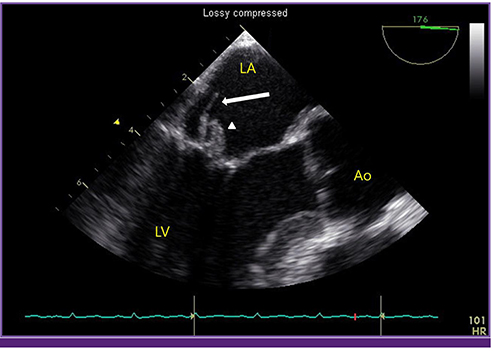Infect Chemother.
2016 Sep;48(3):239-245. 10.3947/ic.2016.48.3.239.
Native Valve Endocarditis due to Corynebacterium striatum confirmed by 16S Ribosomal RNA Sequencing: A Case Report and Literature Review
- Affiliations
-
- 1Department of Internal Medicine, Catholic University of Daegu School of Medicine, Daegu, Korea. popear01@naver.com
- 2Department of Laboratory Medicine, Catholic University of Daegu School of Medicine, Daegu, Korea.
- KMID: 2466440
- DOI: http://doi.org/10.3947/ic.2016.48.3.239
Abstract
- Corynebacterium species are non-fermentous Gram-positive bacilli that are normal flora of human skin and mucous membranes and are commonly isolated in clinical specimens. Non-diphtheriae Corynebacterium are regarded as contaminants when found in blood culture. Currently, Corynebacterium striatum is considered one of the emerging nosocomial agents implicated in endocarditis and serious infections. We report a case of native-valve infective endocarditis caused by C. striatum, which was misidentified by automated identification system but identified accurately by 16S ribosomal RNA sequencing, in a 55-year-old male patient. The patient had two mobile vegetations on his mitral valve, both of which had high embolic risk. Through surgical valve replacement and an antibiotic regimen, the patient recovered completely. In unusual clinical scenarios, C. striatum should not be simply dismissed as a contaminant when isolated from clinical specimens. The possibility of C. striatum infection should be considered even in an immunocompetent patient, and we suggest a genotypic assay, such as 16S rRNA sequencing, to confirm species identity.
Keyword
MeSH Terms
Figure
Cited by 1 articles
-
Microbiological Characteristics of Corynebacterium striatum, an Emerging Pathogen
Sae Am Song, Jeong Hwan Shin
Hanyang Med Rev. 2018;38(2):93-98. doi: 10.7599/hmr.2018.38.2.93.
Reference
-
1. Funke G, von Graevenitz A, Clarridge JE 3rd, Bernard KA. Clinical microbiology of coryneform bacteria. Clin Microbiol Rev. 1997; 10:125–159.
Article2. Rufael DW, Cohn SE. Native valve endocarditis due to Corynebacterium striatum: case report and review. Clin Infect Dis. 1994; 19:1054–1061.
Article3. Lee PP, Ferguson DA Jr, Sarubbi FA. Corynebacterium striatum: an underappreciated community and nosocomial pathogen. J Infect. 2005; 50:338–343.
Article4. Boltin D, Katzir M, Bugoslavsky V, Yalashvili I, Brosh-Nissimov T, Fried M, Elkayam O. Corynebacterium striatum--a classic pathogen eluding diagnosis. Eur J Intern Med. 2009; 20:e49–52.5. Yang HS, Kim YJ, Cho SY, Shin E, Lee HJ. Central venous catheter-related bloodstream infection by Corynebacterium striatum identified by 16S rRNA and rpoB gene sequencing. Ann Lab Med. 2015; 35:548–550.
Article6. Khamis A, Raoult D, La Scola B. Comparison between rpoB and 16S rRNA gene sequencing for molecular identification of 168 clinical isolates of Corynebacterium . J Clin Microbiol. 2005; 43:1934–1936.
Article7. Weiss K, Labbé AC, Laverdière M. Corynebacterium striatum meningitis: case report and review of an increasingly important Corynebacterium species. Clin Infect Dis. 1996; 23:1246–1248.
Article8. Riegel P, Ruimy R, Christen R, Monteil H. Species identities and antimicrobial susceptibilities of corynebacteria isolated from various clinical sources. Eur J Clin Microbiol Infect Dis. 1996; 15:657–662.
Article9. Kim R, Reboli AC. Principles and practice of infectious diseases. 8th ed. New York: Elsevier Saunders;2015. p. 2373–2382.10. Elshibly S, Xu J, Millar BC, Armstrong C, Moore JE. Molecular diagnosis of native mitral valve endocarditis due to Corynebacterium striatum . Br J Biomed Sci. 2006; 63:181–184.
Article11. Iaria C, Stassi G, Costa GB, Biondo C, Gerace E, Noto A, Spinella SG, David A, Cascio A. Outbreak of multi-resistant Corynebacterium striatum infection in an Italian general intensive care unit. J Hosp Infect. 2007; 67:102–104.
Article12. Tran TT, Jaijakul S, Lewis CT, Diaz L, Panesso D, Kaplan HB, Murray BE, Wanger A, Arias CA. Native valve endocarditis caused by Corynebacterium striatum with heterogeneous high-level daptomycin resistance: collateral damage from daptomycin therapy? Antimicrob Agents Chemother. 2012; 56:3461–3464.
Article13. Oliva A, Belvisi V, Iannetta M, Andreoni C, Mascellino MT, Lichtner M, Vullo V, Mastroianni CM. Pacemaker lead endocarditis due to multidrug-resistant Corynebacterium striatum detected with sonication of the device. J Clin Microbiol. 2010; 48:4669–4671.
Article14. Bosshard PP, Kronenberg A, Zbinden R, Ruef C, Bottger EC, Altwegg M. Etiologic diagnosis of infective endocarditis by broad-range polymerase chain reaction: a 3-year experience. Clin Infect Dis. 2003; 37:167–172.
Article15. Ha YE, Ryu SY, Ko KS, Joo EJ, Park SY, Kim HA, Lim MH, Kang CI, Chung DR, Song JH, Park PW, Peck KR. Native valve infective endocarditis due to Staphylococcus lugdunensis confirmed by 16S ribosomal RNA sequencing. Infect Chemother. 2011; 43:372–376.
Article16. Yoo G, Kim J, Uh Y, Lee HG, Hwang GY, Yoon KJ. Multidrug-resistant Corynebacterium striatum bacteremia: first case in Korea. Ann Lab Med. 2015; 35:472–473.
Article
- Full Text Links
- Actions
-
Cited
- CITED
-
- Close
- Share
- Similar articles
-
- Native Valve Infective Endocarditis due to Staphylococcus lugdunensis Confirmed by 16S Ribosomal RNA Sequencing
- First Case of Bartonella quintana Endocarditis in Korea
- Two Cases of Medical Device-Related Corynebacterium striatum Infection: A Meningitis and A Sepsis
- Identification of Gemella species by 16S ribosomal RNA gene sequencing from two patients with infective endocarditis
- A case of bioprosthetic valve endocarditis by corynebacterium in hemodyalysis patients


